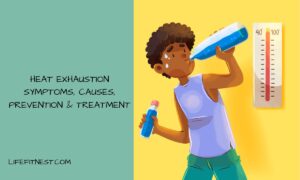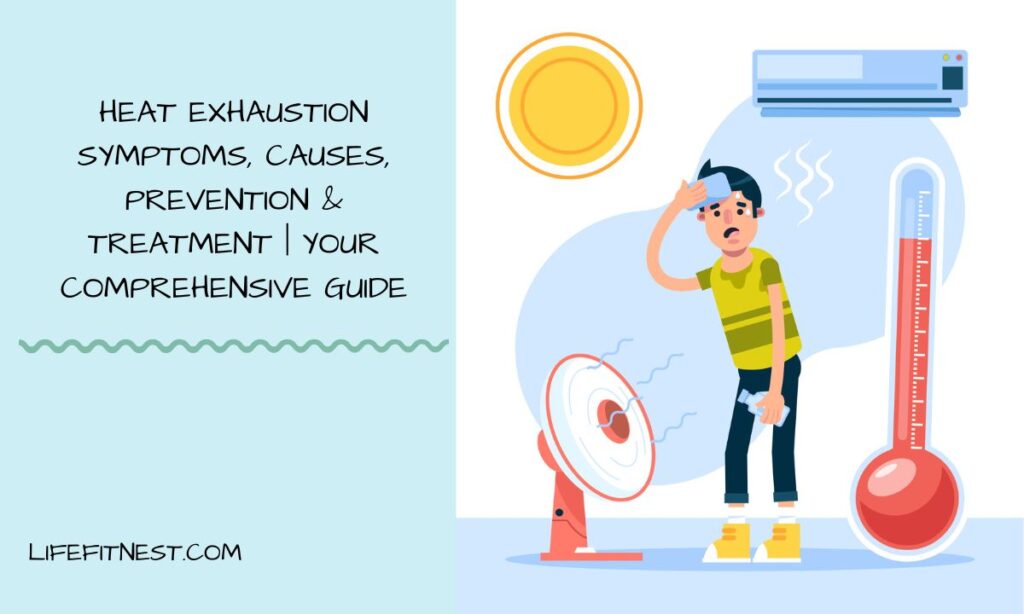is a heat-related illness caused by the body overheating as a result of prolonged exposure to high temperatures and insufficient fluid intake. Heavy sweating, weakness, nausea, dizziness, and an elevated heart rate are some of the common symptoms. If not treated immediately, heat exhaustion can progress to heatstroke, a more severe condition. To avoid further complications, move to a cooler environment, hydrate, and rest. If your symptoms persist or worsen, seek medical attention.
Symptoms of Heat exhaustion
Heat exhaustion symptoms can develop gradually or suddenly. It typically begins with the appearance of a red rash (heat rash) or heat cramps. These cramps usually appear in the arms or legs but can affect any muscle. It is critical to identify these for early intervention. Some common symptoms are:
- Blurred vision
- Headache
- Dizziness
- Fever (above 1000 F)
- Weakness, exhaustion, or fainting
- Nausea or vomiting.
- Shallow breaths.
- Excessive sweating and cold, moist skin
- Oedema, or swelling of the feet, ankles, and hands
- Orthostatic hypotension is characterized by a rapid heartbeat and low blood pressure, particularly while standing.
Causes of Heat Exhaustion.
Sweating and other physical activities cause your body to lose fluids and electrolytes. Sweating acts as a natural air conditioner, cooling the body. Electrolytes are sodium and potassium minerals that help the body function normally. If these fluids and electrolytes are not replenished, your body loses excessive fluid and sodium (salt), resulting in dehydration. Dehydration can cause heat exhaustion.
Aside from this, some additional factors may increase the risk of heat exhaustion:
- Liver or kidney issues
- underlying conditions such as diabetes or hyperglycemia.
- Crush injuries occur when a part of the body is compressed or pinned down by a heavy object.
- Substance abuse
- Excessive and prolonged consumption of alcohol
- Using smoking or tobacco.
- Being obese or overweight
- Depression, insomnia, allergies, and poor circulation are some medical conditions that may increase the risk of dehydration with medication.
- High Blood Pressure
- Heart disease.
- Being under four or over 65 years old
Treatment of Heat Exhaustion
The most effective and immediate way to relieve heat exhaustion is to get away from the heat and go somewhere cool, preferably in an air-conditioned room. If that is not possible, find the nearest shaded area and rest. The other treatment measures are:
- Hydration: After moving to a cool, shady location, the first thing you should do is hydrate yourself. To replenish lost fluids and minerals, drink cool water or electrolyte-containing sports drinks.
- Loosening your clothes allows more air to enter your body and facilitates heat dissipation.
- Rest: lie flat on your back, allowing your body to heal. Only participate in strenuous activities once you feel completely fine.
- Using water or ice: Placing a cool, wet cloth on the face and chest allows the body to regulate and lower its temperature. Placing ice packs under each armpit and behind the neck can help in extreme cases.
Even if the above measures do not work, it is recommended that you seek the assistance of a professional healthcare provider.

Prevention of Heat Exhaustion
Knowing how to treat heat exhaustion symptoms is beneficial, but it is preferable to avoid these heat-related conditions altogether. The following strategies can be useful in protecting you against heat exhaustion:
- Staying hydrated: If you participate in sports or other strenuous physical activities, it is critical to maintain a healthy fluid intake, especially in hot and humid weather.
- Wear loose Clothes: Wear loose or breathable clothes while performing physical activity.
- Avoid the sun: In hot weather, avoid exercising or engaging in physical activities in direct sunlight. It is recommended to work in the early morning or late evening when temperatures are lower.
- Acclimatization: Your body gradually adjusts to hot temperatures, allowing it to adapt over time.
Conclusion
Finally, understanding the fine details of heat exhaustion is important for our health, especially if we live in hot climates. Understanding the symptoms, causes, treatment, and prevention strategies can help protect you and your loved ones from the potential dangers of extreme heat. As a result, staying informed and hydrated is essential for enjoying a safe and healthy environment, especially in the face of rising temperatures.
Must Read: Hearing Aids and Cochlear Implants: What You Need to Know
FAQs
Q1. Who is at greatest risk of heat exhaustion?
A1. Young children and the elderly are most susceptible to heat exhaustion. People with chronic illnesses or those taking certain medications that cause dehydration are also at risk. This cluster includes people who work outdoors as well as athletes.
Q2. What’s the distinction between heat exhaustion and heatstroke?
A2. If ignored, heat exhaustion can progress to heat stroke. Heat exhaustion is not fatal, but it can develop into life-threatening heatstroke. Unlike heat exhaustion, heat stroke can cause mental impairment and loss of consciousness. Heatstroke is more severe and affects vital organs.
Q3. What steps can be taken to avoid heat exhaustion?
A3. Some preventive measures include:
- Stay hydrated.
- Relax in the hot weather.
- Choose light, breathable clothes.
- Plan outdoor activities for cooler weather.
- Take breaks during your exercise to rest and cool down.
Q4: How can workplaces promote heat exhaustion prevention?
A4. Make your workplace heat-safe by providing shade, encouraging breaks, establishing hydration stations, and educating employees on how to recognize and manage heat-related symptoms.


![Understanding Leukemia: A Comprehensive Overview [2024]](https://newstechblog.com/wp-content/uploads/2024/08/cancerHealth-1-1024x536.png)
![Coughing up Phlegm: Causes, Symptoms, and Treatment [2024]](https://newstechblog.com/wp-content/uploads/2024/08/Coughing-up-Phlegm-Causes-Symptoms-and-Treatment-1024x614.jpg)